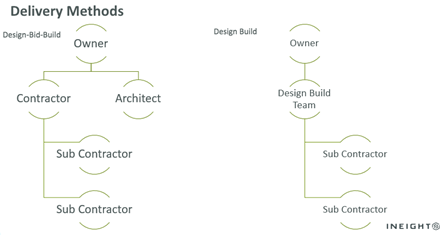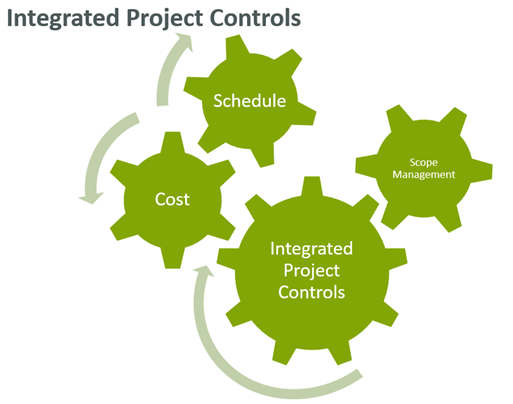The lack of collaboration between the designer and contractor has driven our industry from the traditional design-bid-build approach to alternative delivery methods. These new methods have reduced unexpected change orders, improved project delivery time, increased client satisfaction and established a better relationship between designers and contractors. However, everything is not quite as easy as it might now seem.
Organizations have had to change how they traditionally execute their projects, which has led to analysis of and changes to existing tools, business processes and program management. Let’s discuss that journey of change within these new delivery methods, and how adding standardization and process to alternative design method projects can help us complete our project controls integrations.
Delivery Methods – Past and Present
First, not all alternative delivery methods are new. So, let’s make sure of what we’re referring to when we talk about alternative delivery methods.
Design-bid-build was the traditional method that was used in the engineering and construction industry in the beginning. For those of you who don’t know, this method follows steps in sequential order just like its name would suggest. The design is completed, then there is a call out for bids from contractors based on the design. The key to this delivery method is that each step has a hand-off; there is not an iterative or collaborative approach between architect/designer and the contractor.

From an infrastructure standpoint, for example, the design-bid-build model was always the norm up until about the mid-eighties to early nineties. Now, one of the most popular models we’re seeing is a progressive design build where the client will select a design build team before they even know the scope of the work that they want to design and build. Then, they’ll work with that team to define what the scope is. In addition, the contractor is part of that team so there is a collaborative approach between all three parties – the client, the contractor, and the engineer.
Changes to delivery methods have downstream impacts to the day-to-day business processes. What challenges are we seeing because of the new methods and how are we addressing them?
With a collaborative approach that emphasizes transparency. This is a necessity because with these alternative delivery methods, the engineers, the contractors, and the owners are all getting a little bit more involved with pieces of the process that aren’t their area of expertise in the hope that potential risks and issues get identified before that first concrete pour. The engineers may not understand the cost implications of a particular design, whereas the contractor might not be aware of the necessity of a specific material. So, while working together collaboratively is a change and can cause some initial tension, the benefits to all parties outweigh the initial discomfort of learning how to work together.
A Changing Relationship Between Owner, Contractor, and Designer
The more transparent you are on a project, the better. Today, with the help of the right technology tools, we can provide our stakeholders daily reports and updates that contribute to this transparency. This tends to make our overall relationships much better, resting in the knowledge that everyone understands what’s happening on a project because it’s all open to everybody.
For example, on EPC projects with design quantity forecasting, we are now able to track engineering quantity updates, which drive commodity-based quantities for construction, such as linear feet of pipe, cubic heads of concrete, etc. We can track those quantity updates monthly, even before the design is complete. From the estimate to when the design is complete, we can get quantity updates as the design evolves — and that really helps reduce risk. This is because we can plan better if there are procurement-related changes, if there’s a higher quantity needed, or if the scope has increased so much that we need to have more staff or more crew on the construction site.

The transparency with our tools and processes today, such as within the InEight integrated platform and processes for integrated project controls, really allows us to provide very reliable data in near-real time. This means we’re not waiting a week or two to look backwards on what we’ve already done and risk re-work or costly changes. The importance of an integrated project critical path method schedule rests on understanding exactly what work has been completed and how much work there is left to be done. This is crucial to creating our schedules, which for most construction projects, are very tight. So, having that reliable, transparent data that we can use to communicate between the client, the contractor and the engineer is critical.
One other thing that we can do within engineering now is track the scope that involves just engineering and not commodities for construction. We can track quantities as sheets, for instance, but also as units of measure that really drive our unit rates. This has helped us a lot in tracking productivity for engineering scope of work. Add weekly updates and providing weekly reports to all parties involved depending on the contract, and that really drives it all home. And we know from an industry perspective that these methods are growing in use.
Driving the Business Process of Change
As far as a timeline for change goes, if you have executive sponsorship and if everybody is ready for the change, it can go very far concerning successful implementation. As to cadence, I would say to implement it on one project, take your lessons learned and then move on to the next project. Once you’ve done one or two projects like this, you might try applying it to one project in every market at the same time and then expand it to the whole market.
From an overall project standpoint, the amount of risk that is reduced in this adoption model is substantial. In a traditional design-bid-build, the engineer completes the design and then contractors bid based on that design. This can cause significant delays in the event the bids don’t come back as acceptable to the owner. Then it’s back to the beginning, with the engineer reworking the design and again, once complete, the contractors providing a bid, or worse, the owner ends up determining the project isn’t feasible due to the costs. But if a more progressive design build method is used, these details are figured out right away because of the collaboration happening between engineer and contractor. The overall project uncertainty from a quantity and cost perspective will continue to drop, minimizing the risk for the owner.
Proper planning is also critical. Working in tandem, engineers and contractors should be creating a baseline plan for what and also when milestones and deliverables can be expected so the construction activities, resources and equipment can also be planned. By planning both engineering and construction activities together, it becomes very easy to see the impact of a design or construction delay to delivering a project on time or early. Critical path can be mapped out to identify areas of risk and focus. While traditionally this information has remained siloed, a more progressive delivery method combines these schedules to ensure the entire project team is on the same page and aware of their downstream impacts.
Moving Forward
For any owner or client that is not utilizing alternative delivery methods, I urge them to examine the benefits of an accelerated schedule; more cost certainty, and less change than in a design-bid-build method where the engineer and the contractor aren’t working together simultaneously. Eliminate the unknowns between engineering and construction by bringing these two groups together during planning and execution. There are a lot of potential rework and scope changes that happen on a design-bid-build delivery. Therefore, it is in the client’s best interest to use a method that encourages collaboration to avoid these risks.
While traditional methods are not likely to go away completely, I think we will see them less and less. Why? With the systems and data collection that are now available, owners can demand more visibility. They know it is possible and can be the determining factor in winning work. Previously, progress reporting was a monthly (at best) process, but this just isn’t the case anymore and the data being collected is driving changes to delivery methods. Changing the way it has always been done is now possible because we have the data to back it up. More collaboration between all parties, as well as a model of sharing risks equally ensures project success. The strength of the relationship between owner, designer and contractor also increases because of the transparency of information.
Ready to take a deeper dive? InEight can help get your projects where they need to go and help you create a solution that matches your needs while leveraging your teams’ existing strengths. Let us show you how.
Sign up for our monthly blog newsletter today and stay up to date on the latest industry news.




